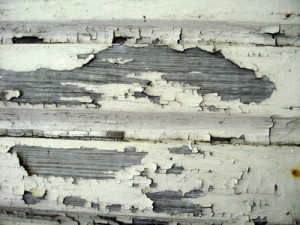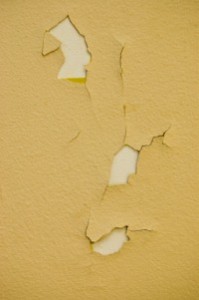an Article by About.com
 House painting is no fun. There, we’ve said it. Interior house painting is one thing–smaller areas, protection from the elements–but exterior house painting can be downright unfriendly.
House painting is no fun. There, we’ve said it. Interior house painting is one thing–smaller areas, protection from the elements–but exterior house painting can be downright unfriendly.
So, that’s why you want to make your paint job last. Who wants to do it again? Not me.
This guide is a reprint of a well-known but highly elusive article called “Why Your House Paint Failed,” from the Forest Products Research Laboratory.
1. Wood was wet when it was painted
If only the surface of the wood is wet, then 1 sunny day is usually needed for drying prior to painting. If wood is saturated, several sunny or windy days are necessary.
2. Unfinished siding was exposed to several weeks of sunlight before painting
Sunlight degrades the unfinished wood surface, thus it will never hold paint as well as fresh wood.
If the unfinished wood is exposed more than 3 to 4 weeks, lightly sand or power wash the surface to remove the thin layer of degraded wood before applying paint.
3. Temperature was too cold when wood was painted.
Oil-based paint should be applied when the temperature is at least 40ºF; for latex paints, it should be 50ºF. Conditions should remain above these temperatures for 24 hours after painting. When pretreating the wood with a paintable water-repellent preservative (a recommended practice), best results are achieved when applied at >70ºF.
4. Wood was too hot when it was painted or was heated soon after painting.
Do not paint when the temperature is 90ºF. To prevent temperature blisters, avoid painting surfaces that will soon be heated. The best procedure is to “follow the sun around the house.” The east side of the building should be painted late in the morning, the south side in the middle of the afternoon, the west side late in the afternoon. The north side can be painted at any time during the day. However, at least 2 hours are needed for fresh paint to dry before the weather cools to the point where dew forms. If blistering on the wood surface does occur, allow the paint to dry for a few days, scrape off the blisters, smooth the edges with sandpaper, and paint the area.
5. Weather was too humid when the surface was painted.
When water-based paints cure, the water should evaporate as fast or faster than the solvents. After the water has evaporated, the paint will shrink to nearly its final shape. As the solvents evaporate, the paint chemically reacts to form a hard material. When it is too humid, water cannot evaporate and the solvents may evaporate first, causing the paint to cure while still in a water-filled state. You cannot recover from this type of disaster. Oil-based paints will also fail if weather conditions are too humid.

6. Humidity in the house was too high during the heating season.
A high level of humidity inside the house is probably the cause if paint failure occurs on the outside walls of the bathroom or kitchen, and it can be even more pronounced on the outside of an upper floor. In multi-story buildings, there is a chimney effect. Warm moist air is trying to vent upstairs, and eventually this moisture travels out through the siding. Paint failure may be more noticeable near electrical outlets or other breaks in the vapor barrier. Drier air enters the house through cracks on the main level; therefore, paint failure caused by high humidity is usually not a problem on the main level. Condensation on the windows also indicates excessive humidity in the house. Turning down your humidifier or turning on a bathroom exhaust fan will help lower the humidity level inside the house. An energy efficient but somewhat expensive solution to high levels of humidity is to install an air-to-air heat exchanger. Here, warm moist air gives its heat to the incoming fresh, dry air.
7. Wood was installed directly over foam or foil-faced insulation board.
Water can travel in behind the siding of the house through various routes but has to travel out through the wood, pushing the paint off. Even if the paint remains on the surface, this moisture can cause other problems. Large overhangs, proper caulking, and a 12-inch minimum ground clearance may decrease the chance of water getting in behind the siding. Additional suggestions to prevent paint failure in this situation include the following:
- Driving small wedges (1/16 inch) under every sixth row of siding may permit water to escape and reduce the moisture problem. However, wind-driven rain may also use this as an access and aggravate the situation.
- Back priming (painting the back of the siding before installation) may help reduce/prevent paint failure.
- Install roofing paper (15- to 30- lb felt) beneath the siding. Note: The best solution is to attach furring strips to the studs through the insulation board, making air spaces behind the siding. Furring strips also make a nice home for bugs, if you do not screen the bottom. A spacer-type webbing called “cedar breather” is sometimes used under wood shingles and may have merit for use under siding.
8. House has no interior vapor barrier.
The absence of an interior vapor barrier is related to the problems of high levels of humidity inside the house during the heating season and wood that was installed directly over foam or foil-faced insulation board. Driving wedges under the siding may be the easiest solution. Applying certain interior vapor- retarding paints and installing electrical outlet gaskets may also be effective, especially on the upper floor of a multi-story house.
9. Wood siding is dirty.
If the siding is dirty, the surface of the siding should be power washed or cleaned with detergent and a stiff bristle or brass brush and rinsed well. Never use steel or iron, which causes iron stain and may glaze the surface.
10. Wood has mill glaze.
Mill glaze can be caused by several factors. For example, if during planing to make smooth wood, the planer blades were dull, running too fast, or pressing too hard on the wood surface, the surface of the wood can become hardened or resins may be drawn to the surface causing a glaze. Whatever the cause, the surface appears to be case hardened. If a drop of water beads up on the wood surface but does not on a lightly sanded surface, you may have what is commonly called mill glaze. If you have mill glaze, the smooth surface must be lightly sanded or power washed to remove the hardened surface. Oddly enough, controlled wetting of new siding with a garden hose may promote better adhesion to the redried wood. The water releases the stresses in the wood. You can also create a type of mill glaze by sand blasting or using a wire wheel on the wood surface. Mill glaze is not a problem on rough-sawn siding.
11. Brown stains appear on the surface of the paint.
Paint does not have to fall off to fail. Moisture traveling through wood pulls water-based extractives through the paint, leaving brown stains on the surface of the paint. If the wood is kept dry, the waterbased extractives in the wood will not bleed through paint. Keeping all moisture out may be difficult. Oil-based primers usually block extractive stains better than latex primers and may be a better choice on redwood and cedar; however, oil paints can increase mildew. Compared with oil-based primers, latex primers produce a more flexible paint film with better durability and can be used when extractive staining is not a problem.
12. Wood has decayed (rotted).
Decayed wood can result if the wood has been wet for extended periods. If the wood is soft and spongy, it is degraded to the point that it will never hold paint and should be replaced.
In summary, note the following to prevent house paint failure (not applicable to semitransparent or solid-color stains):
- Install siding properly.
- Sand or power wash the surface of the wood if it is smooth.
- Apply paint during recommended weather conditions and temperatures.
- Treat the surface of the wood with a paintable water-repellent preservative (especially the end grain).
- Prime the surface of the wood with a stain-blocking primer.
- Properly apply caulking material.

